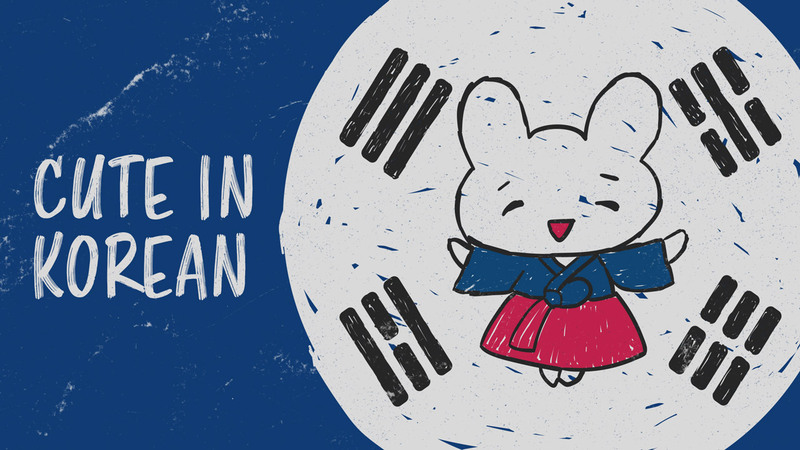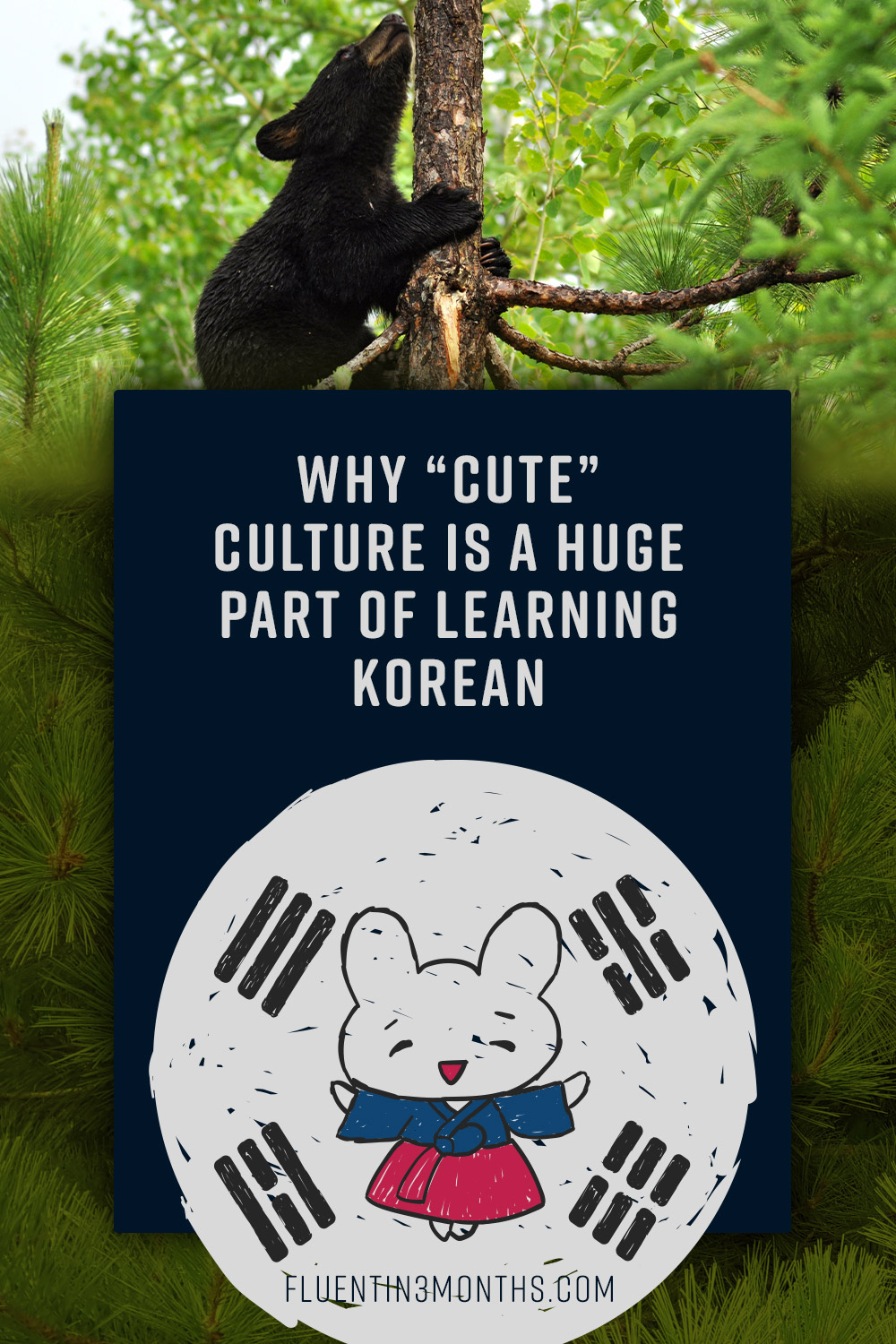“Cute” in Korean and 44 More “Aegyo” Korean Phrases
If you’re learning Korean, you may have wondered how to say “cute” in Korean or asked what does aegyo mean. Because “cute” culture is a big part of learning Korean, and you’ll run into it everywhere!
In fact, if you’ve watched Korean dramas at all, you’ve most definitely heard and witnessed aegyo and Korean emphasis on cuteness.
That’s because many women in Korea want to be seen as cute — which is one of the best compliments you can give someone. Very similar to kawaii culture in Japan, being called “cute” is top praise in Korea.
This may surprise you a bit if you’re from an English-speaking country, because “cute” is often patronizing, especially after childhood.
So, here’s how to say “cute” in Korean — as well as some bonus words, phrases, and tips for sounding cute!
How to Say “Cute” in Korean
“Cute” in Korean is 귀엽다 (gwiyeopda). That’s its dictionary form, so it actually means “to be cute.”
귀엽다 (gwiyeopda) is perfectly fine to say to yourself, or in exclamation about something cute you see — like a cute puppy! (Because don’t we all do that?)
But like all things in Korean, you need to remember to change the ending of the word to be the appropriate politeness level.
When you’re talking with friends, family, or someone on the same “level” as you (for instance, the same age or younger), then you can use the casual form.
Drop the -pda ending and add -wo: 귀여워 (gwiyeowo)
In standard polite form, you just add -yo onto the casual form: 귀여워요 (gwiyeowoyo). Use this version at work, with people older than you, a teacher, boss, or anyone “above” you in rank or age.
Last up, the most formal way to say “cute” is by adding the -seumnida ending. For this one, drop the -da and add -seumnida to the dictionary form: 귀엽습니다 (gwiyeopseumnida).
The most formal form of the word is used mostly on TV or when speaking to large audiences. For example, you’ll often hear this formal form used to talk about aegyo celebrities who have built their image around cuteness.
But you’ll use the casual or polite forms most often.
“You are Cute” in Korean
To say “you are cute” in Korean, you actually don’t need to change anything at all. You can just say 귀여워 (gwiyeowo) (or the appropriate variation).
In Korean, the subject is often left out as long as it’s understood. So you can use this phrase to mean “it’s cute,” “she’s cute” or “you’re cute”.
But if you want to use “cute” to modify a noun, then you’d use 귀여운 (gwiyeoun).
For example, if you see a cute Korean girl, you could say 귀여운 소녀 (gwiyeoun sonyeo).
A cute puppy? That’s 귀여운 강아지 (gwiyeoun gangaji).
Here are some other nouns you may want to pair with 귀여운 (gwiyeoun):
- Baby: 아기 (agi)
- Cat: 고양이 (goyang-i)
- Animal: 동물 (dongmul)
- Dress: 드레스 (deureseu)
- Shoes: 신발 (sinbal)
- Outfit: 차림새 (charimsae)
- Person: 사람 (saram)
For that last one though, you could also say 귀요미 (gwiyomi), which means “cutie” or “cute person”.
If you want to exclaim “So cute!” or “Too cute!”, just add 너무 (neomu, “too”) to make 너무 귀여워! (neomu gwiyeowo!).
Complimenting a Guy: “Handsome” in Korean
Now, you’ll notice I didn’t say you could use any of those words above to mean “he is cute” — because you wouldn’t say that in Korean. Instead, use the word 잘생겼다 (jalsaenggyeotta) which means “handsome” or “good looking”.
That’s the dictionary form, but you’ll conjugate it like you did with 귀엽다 (gwiyeopda).
Casual: 잘생겼어 (jalsaenggyeosseo)
Polite: 잘생겼어요 (jalsaenggyeosseoyo)
Formal: 잘생겼습니다 (jalsaenggyeotseumnida)
Aegyo Korean — What is Aegyo?
As we’ve mentioned so far, aegyo is “cute” culture — it’s a way of speaking and acting cute in Korean.
Aegyo is super popular among Korean celebrities, especially K-Pop idols (both genders) and actresses.
Basically, it’s acting childish or babyish in some way. Aegyo can also be a visual aesthetic — the way you dress (think like Hello Kitty-style) or how you present yourself.
Aegyo has become a way to flirt or show affection too, and it’s primarily used by women to men.
That said, aegyo can come off a bit whiny or annoying. So even though “cute” culture is popular and common in “Hallyuwood” (the “Korean wave” + Hollywood, meaning the Korean entertainment industry), it’s not always well-received. In fact, some people straight-up hate aegyo.
Because of that, some women use it on purpose to tease their husband or boyfriend, or to joke around.
And aegyo can typically only be pulled off by people who are “naturally cute”. So someone who doesn’t fit the general aesthetic would come off weird using aegyo. For instance, it’s often a comedy gag for older men to use aegyo.
But that’s true with anything right? Even in Western cultures, we have this — think Instagram aesthetic and how it’s a gag for dads to mock their daughter’s IG game.
How to Use Aegyo
There are lots of ways to use aegyo. The two many ways to use aegyo in speech are to draw out the final vowel sound in a word or to add ㅁ (“m”) or ㅇ (“ng”) to the end of the word.
Let’s look at the first example. The most common aegyo word is probably 오빠 (oppa), which means “older brother” but is also used as a cute nickname for boyfriends and husbands.
Since it’s often used with one’s significant other, it’s super common to hear women draw out the “ah” sound at the end to make it sound “cuter.” So it ends up sounding like “Oppaaaaaaa!”
If you’ve watched K-Dramas at ALL, I know you’ve heard what I’m talking about here.
Other common words to use this with are exclamation words like 어떻게 (eotteoke, “How?”) or 세상에 (sesangae, “Oh my God!” or “What in the world?!”). And of course, whining “I’m hungry” with 배고팡 (baegopang).
This video on YouTube shows you just how dramatic it can sound.
Now, when it comes to the second way to use aegyo in speech, you’ll add the “m” or “ng” sound to the end of the word.
Looking at oppa again, it becomes 오빵 (oppang). Another common one is 어디야 (eodiya) which means “Where are you?”. Add on the “m” sound and it becomes 어디얌 (eodiyam).
You’ll see this often in text, as well, followed by tons of cute emojis.
But you can also use aegyo with your body language. For example, bbuing bbuing, or the “crying” gesture is a favorite among K-Pop idols. You’ll also see lots of hearts and face-framing!
Cute Korean Words and Phrases
Okay, you’ve learned about aegyo, so now it’s time to learn some cute Korean words and phrases! You can use these with your significant other or friends whenever you want to sound extra cute. Plus, some cute and romantic phrases in Korean to say to your love interests.
- “Aren’t I cute?” – 내가 귀엽지? (naega gwiyeobji)
- “I love you” – 사랑해요 (saranghaeyo)
- “I miss you” – 보고 싶어 (bogo sipeo)
- “Sweetheart” – 애인 (ae-in)
- “Honey” or “Darling” – 여보 (yeobo)
- “Baby” – 자기야 (jagiya)
- “Don’t go” – 가지마 (gajima)
- “BFF” – 베프 (bepeu)
- “Honey jam” (aka, something’s really fun) – 꿀잼 (gguljaem)
- “Be happy” (used to say goodbye) – 행쇼 (haengsyo)
- “You’re pretty” – 예쁘 네요 (yeppeuneyo)
- “Don’t lie” – 뻥치지마 (ppeongchijima)
- “Like this?” – 이렇게 (irreoke)
- “Buy this for me” (Make sure to be super whiny!) – 사줘 (sajwo)
- “I promise” – 약속애요 (yaksokaeyo)
Remember, some of these you could add on cute exaggerated endings as well to make even cuter! A lot of it comes down to context and your tone.
And don’t forget to pair it with your cute hand gestures!
Go On – Be Cute in Korean!
Go ahead and show your cute side off in Korean! And if you want more examples, make sure you watch some Korean TV shows and see how aegyo is done.
But wait — 가지마! (gajima!), “Don’t go!”
There’s still so much Korean left to learn!
If you’re new to the language, then you have to learn these Korean phrases to ace your first conversation. And the 101 core Korean words are so helpful for building your Korean vocabulary fast!
And if you want to know more about Korean and Korean culture, then learn WTF is mukbang or check out my review of 90 Day Korean so you can master the language while learning the culture!




Social